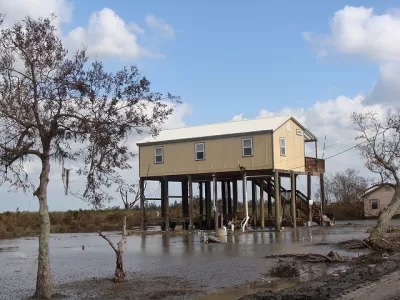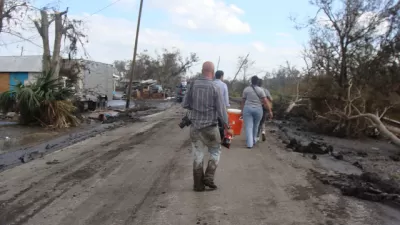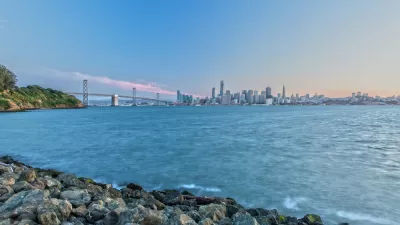The 99 residents of Isle de Jean Charles have $48 million to relocate together, but that doesn’t make it easy.

One of the winners of the National Disaster Resiliency Competition in 2014 was project that aspired to relocate a community of 99 people who live at the end of a watery road on isle de Jean Charles, Louisiana. Last week, CityLab published an extensive update on what has happened since America’s "first climate refugees" were awarded $48 million to move out their homes.
Like much of the Louisiana Gulf Coast, the island—which is populated by the Isle de Jean Charles Band of the Biloxi-Chitimacha-Choctaw Tribe—has been deeply affected by both rising seas and sinking lands, which are attributable to both climate change and to the daily operations of industry. The island, Michael Isaac Stein reports, has lost 98 percent of its mass over the last six decades.
“Levees stopped the natural flow of fresh water and sediment that reinforced the fragile marshes. Oil and gas companies dredged through the mud to lay pipelines and build canals, carving paths for saltwater to intrude and kill the freshwater vegetation that held the land together. The unstoppable, glacial momentum of sea-level rise has only made things worse. Today, almost nothing remains of what was very recently a vast expanse of bountiful marshes and swampland.”
The Isle de Jean Charles Resettlement Project is not the first time coastal residents have been displaced by environmental factors, nor is it the last time the government will have to try to relocate them. But it is the first time anyone has hoped to move an entire community, together, to higher ground.
Progress is slow, partly because the residents of the island are justifiably untrusting of government efforts to uproot them.
“Isle de Jean Charles was, in fact, created as a result of a government-mandated relocation, albeit of a very different nature. It was during the violent Indian Removal Act era, when Native Americans were being murdered and driven off any land that could be used for agriculture.”
It’s also slow because “the government is simply not good at resettling communities,” Stein writes. “Whether this deficiency is a product of inexperience or the sclerotic nature of bureaucracy is one of the things policy makers are trying to figure out.”
Finally, there’s also the fact that 99 people have to agree on a feasible plan. Project managers have at least narrowed down potential locations.
“The most likely site for the new town is a sugar farm in the northern part of the same parish, Terrebonne Parish. The Evergreen property, as it’s called, was picked out of 16 potential sites and checks off the central wishes of the residents: It’s on higher land, it’s closer to a city than the old town but still rural, and it retains what Isle de Jean Charles residents value most about their home—peace and quiet.”
FULL STORY: How to Save a Town From Rising Waters

Study: Maui’s Plan to Convert Vacation Rentals to Long-Term Housing Could Cause Nearly $1 Billion Economic Loss
The plan would reduce visitor accommodation by 25,% resulting in 1,900 jobs lost.

North Texas Transit Leaders Tout Benefits of TOD for Growing Region
At a summit focused on transit-oriented development, policymakers discussed how North Texas’ expanded light rail system can serve as a tool for economic growth.

Using Old Oil and Gas Wells for Green Energy Storage
Penn State researchers have found that repurposing abandoned oil and gas wells for geothermal-assisted compressed-air energy storage can boost efficiency, reduce environmental risks, and support clean energy and job transitions.

Private Donations Propel Early Restoration of Palisades Playground
Los Angeles has secured over $1.3 million in private funding to restore the Pacific Palisades playground months ahead of schedule, creating a modern, accessible space that supports community healing after recent wildfires.

From Blight to Benefit: Early Results From California’s Equitable Cleanup Program
The Equitable Community Revitalization Grant (ECRG) program is reshaping brownfield redevelopment by prioritizing projects in low-income and environmental justice communities, emphasizing equity, transparency, and community benefits.

Planting Relief: Tackling Las Vegas Heat One Tree at a Time
Nevada Plants, a Las Vegas-based nonprofit, is combating the city’s extreme urban heat by giving away trees to residents in underserved neighborhoods, promoting shade, sustainability, and community health.
Urban Design for Planners 1: Software Tools
This six-course series explores essential urban design concepts using open source software and equips planners with the tools they need to participate fully in the urban design process.
Planning for Universal Design
Learn the tools for implementing Universal Design in planning regulations.
Ascent Environmental
Borough of Carlisle
Institute for Housing and Urban Development Studies (IHS)
City of Grandview
Harvard GSD Executive Education
Toledo-Lucas County Plan Commissions
Salt Lake City
NYU Wagner Graduate School of Public Service





























